Nakatomi Space
 [Image: From Die Hard, directed by John McTiernan based on the novel Nothing Lasts Forever by Roderick Thorpe].
[Image: From Die Hard, directed by John McTiernan based on the novel Nothing Lasts Forever by Roderick Thorpe].While watching Die Hard the other night—easily one of the best architectural films of the past 25 years—I kept thinking about an essay called "Lethal Theory" by Eyal Weizman—itself one of the best and most consequential architectural texts of the past decade (download the complete PDF).
In it, Weizman—an Israeli architect and prominent critic of that nation's territorial policy—documents many of the emerging spatial techniques used by the Israeli Defense Forces in their high-tech, legally dubious 2002 invasion of Nablus. During that battle, Weizman writes, "soldiers moved within the city across hundred-meter-long 'overground-tunnels' carved through a dense and contiguous urban fabric." Their movements were thus almost entirely camouflaged, with troop movements hidden from above by virtue of always remaining inside buildings. "Although several thousand soldiers and several hundred Palestinian guerrilla fighters were maneuvering simultaneously in the city," Weizman adds, "they were so 'saturated' within its fabric that very few would have been visible from an aerial perspective at any given moment."
Worthy of particular emphasis is Weizman's reference to a technique called "walking through walls":
- Furthermore, soldiers used none of the streets, roads, alleys, or courtyards that constitute the syntax of the city, and none of the external doors, internal stairwells, and windows that constitute the order of buildings, but rather moved horizontally through party walls, and vertically through holes blasted in ceilings and floors.
This is how the troops could "adjust the relevant urban space to our needs," he explains, and not the other way around.
Indeed, the commander thus exhorted his troops as follows: "There is no other way of moving! If until now you were used to moving along roads and sidewalks, forget it! From now on we all walk through walls!"
 [Image: Israeli troops scan walls in a refugee camp; photo by Nir Kafri (2003), from Eyal Weizman's essay "Lethal Theory"].
[Image: Israeli troops scan walls in a refugee camp; photo by Nir Kafri (2003), from Eyal Weizman's essay "Lethal Theory"].Weizman illustrates the other side of this terrifyingly dislocating experience by quoting an article originally published during the 2002 invasion. Here, a Palestinian woman, whose home was raided, recounts her witnessing of this technique:
- Imagine it—you’re sitting in your living room, which you know so well; this is the room where the family watches television together after the evening meal. . . . And, suddenly, that wall disappears with a deafening roar, the room fills with dust and debris, and through the wall pours one soldier after the other, screaming orders. You have no idea if they’re after you, if they’ve come to take over your home, or if your house just lies on their route to somewhere else. The children are screaming, panicking. . . . Is it possible to even begin to imagine the horror experienced by a five-year-old child as four, six, eight, twelve soldiers, their faces painted black, submachine guns pointed everywhere, antennas protruding from their backpacks, making them look like giant alien bugs, blast their way through that wall?
In any case, post-battle surveys later revealed that "more than half of the buildings in the old city center of Nablus had routes forced through them, resulting in anywhere from one to eight openings in their walls, floors, or ceilings, which created several haphazard crossroutes"—a heavily armed improvisational navigation of the city.
So why do I mention all this in the context of Die Hard? The majority of that film's interest, I'd suggest, comes precisely through its depiction of architectural space: John McClane, a New York cop on his Christmas vacation, moves through a Los Angeles high-rise in basically every conceivable way but passing through its doors and hallways.
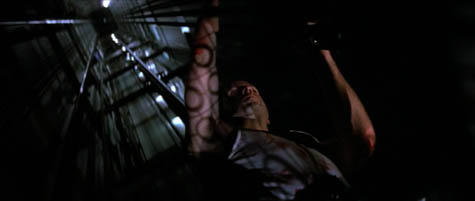
 [Images: From Die Hard].
[Images: From Die Hard].McClane explores the tower—called Nakatomi Plaza—via elevator shafts and air ducts, crashing through windows from the outside-in and shooting open the locks of rooftop doorways. If there is not a corridor, he makes one; if there is not an opening, there will be soon.

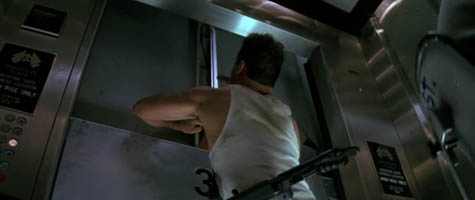
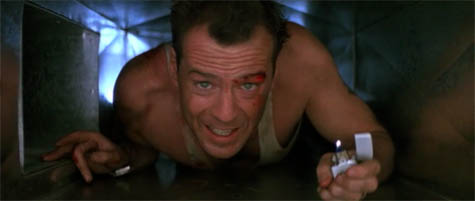 [Images: From Die Hard].
[Images: From Die Hard].Over the course of the film, McClane blows up whole sections of the building; he stops elevators between floors; and he otherwise explores the internal spaces of Nakatomi Plaza in acts of virtuoso navigation that were neither imagined nor physically planned for by the architects.
His is an infrastructure of nearly uninhibited movement within the material structure of the building.
The film could perhaps have been subtitled "lessons in the inappropriate use of architecture," were that not deliberately pretentious. But even the SWAT team members who unsuccessfully raid the structure come at it along indirect routes, marching through the landscaped rose garden on the building's perimeter, and the terrorists who seize control of Nakatomi Plaza in the first place do so after arriving through the service entrance of an underground car park.
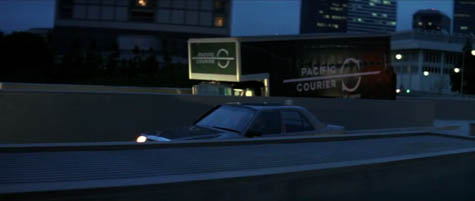
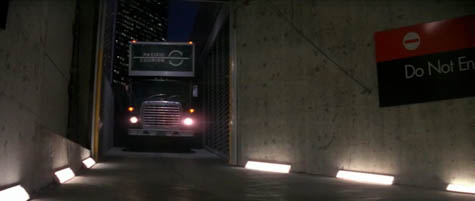 [Images: From Die Hard].
[Images: From Die Hard].What I find so interesting about Die Hard—in addition to unironically enjoying the film—is that it cinematically depicts what it means to bend space to your own particular navigational needs. This mutational exploration of architecture even supplies the building's narrative premise: the terrorists are there for no other reason than to drill through and rob the Nakatomi Corporation's electromagnetically sealed vault.
Die Hard asks naive but powerful questions: If you have to get from A to B—that is, from the 31st floor to the lobby, or from the 26th floor to the roof—why not blast, carve, shoot, lockpick, and climb your way there, hitchhiking rides atop elevator cars and meandering through the labyrinthine, previously unexposed back-corridors of the built environment?
Why not personally infest the spaces around you?
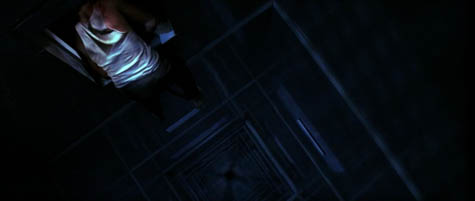

 [Images: From Die Hard].
[Images: From Die Hard].I might even suggest that what would have made Die Hard 2 an interesting sequel—sadly, the series is unremarkable for the fact that each film is substantially worse than the one before—would have been if Die Hard's spatial premise had been repeated on a much larger urban scale.
For example, Weizman outlines what the Israeli Defense Forces call "hot pursuit"—that is, to "break into Palestinian controlled areas, enter neighborhoods and homes in search of suspects, and take suspects into custody for purposes of interrogation and detention." This becomes a spatially extraordinary proposition when you consider that someone could be kidnapped from the 4th floor of a building by troops who have blasted through the walls and ceilings, coming down into that space from the 5th floor of a neighboring complex—and that the abductors might only have made it that far in the first place after moving through the walls of other structures nearby, blasting upward through underground infrastructure, leaping terrace-to-terrace between buildings, and more.
An alternative-history plot for a much better Die Hard 2 could thus perhaps include a scene in which the rescuing squad of John McClane-led police officers does not even know what building they are in, a suitably bewildering encapsulation of this method of moving undetected through the city.
"Walking through walls" thus becomes a kind of militarized parkour.
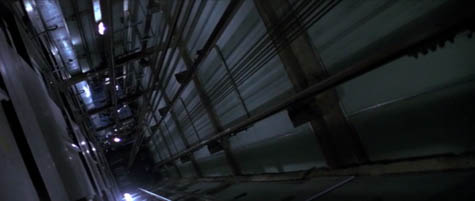 [Image: Inside Nakatomi space, from Die Hard].
[Image: Inside Nakatomi space, from Die Hard].Indeed, recent films like The Bourne Ultimatum, Casino Royale, District 13, and many others could be viewed precisely as the urban-scale realization of Die Hard's architectural scenario. Even The Bank Job—indeed, any bank heist film at all involving tunnels—makes this Weizmanian approach to city space quite explicit.
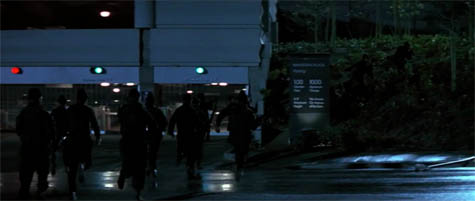 [Image: From Die Hard; it's hard to see here, but an LAPD SWAT team is raiding the Nakatomi Building by way of lateral movements across the surrounding landscape].
[Image: From Die Hard; it's hard to see here, but an LAPD SWAT team is raiding the Nakatomi Building by way of lateral movements across the surrounding landscape].Tangentially, I'm reminded of Matt Jones's thought-provoking 2008 blog post about the urban differences between the Jason Bourne and James Bond film franchises. Jones writes that "there’s no travel in the new Bond"; there are simply "establishing shots of exotic destinations." By the end of a Bond film, he adds, you simply "feel like you are in the international late-capitalist nonplace," a geography with neither landmarks nor personal memory.
Compare the paradoxically unmoving, amnesiac geography of James Bond, then, to the compressed spaces of Paul Greengrass-directed Jason Bourne films. These films are "set in Schengen," Jones writes, "a connected, border-less Mitteleurope that can be hacked and accessed and traversed—not without effort, but with determination, stolen vehicles and the right train timetables." Indeed, Jones memorably suggests, "Bourne wraps cities, autobahns, ferries and train terminuses around him as the ultimate body-armor."
- Rather than Bond’s private infrastructure [of] expensive cars and toys, Bourne uses public infrastructure as a superpower. A battered watch and an accurate U-Bahn time-table are all he needs for a perfectly-timed, death-defying evasion of the authorities.
If Jason Bourne's actions make visible the infrastructure-rich, borderless world of the EU, then John McClane shows us a new type of architectural space altogether—one that we might call, channeling topology, Nakatomi space, wherein buildings reveal near-infinite interiors, capable of being traversed through all manner of non-architectural means. In all three cases, though—with Bond, Bourne, and McClane—it is Hollywood action films that reveal to us something very important about how cities can be known, used, and navigated: these films are filled with the improvisational crossroutes that constitute Eyal Weizman's "Lethal Theory."
As I wrote the other day, crime is a way to use the city.
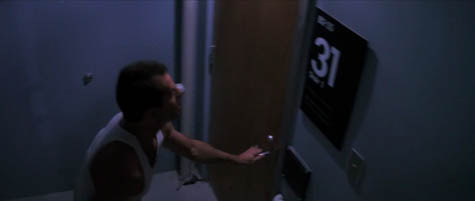 [Image: From Die Hard].
[Image: From Die Hard].On the other hand, as Weizman points out, this is not a new approach to built space at all:
- In fact, although celebrated now as radically new, many of the procedures and processes described above have been part and parcel of urban operations throughout history. The defenders of the Paris Commune, much like those of the Kasbah of Algiers, Hue, Beirut, Jenin, and Nablus, navigated the city in small, loosely coordinated groups moving through openings and connections between homes, basements, and courtyards using alternative routes, secret passageways, and trapdoors.
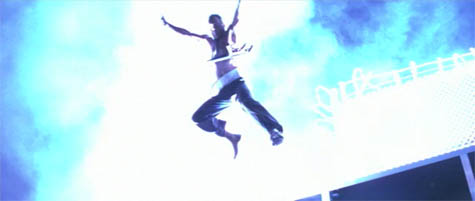 [Image: From Die Hard].
[Image: From Die Hard].Treated as an architectural premise, Die Hard becomes an exhilarating catalog of unorthodox movements through space. I would suggest again, then, that where the various Die Hard sequels went wrong was in abandoning this spatial investigation—one that could very easily have been scaled-up to encompass a city—and following, instead, the life of one character: John McClane. But, when taken out of Nakatomi Plaza—that is, out of the boundless, oceanic fluidity of Nakatomi space—McClane is reduced to an action film cliché whose failing charisma no amount of wise-cracking can salvage.
(I remembered while writing this post that I actually discussed Die Hard on National Public Radio last year; you can listen to that show here).





Comments are moderated.
If it's not spam, it will appear here shortly!
Great post, not only because I myself thought like this when watching Die Hard (incidentally, the best Christmas movie ever), but also because I have recently finished Zizek's 'Defence of Lost Causes' book which talks about the Israeli army 'smoothing out' the urban space in warfare scenarios. Your mention of parkour is particularly crucial for me as I recently wrote an article in EPD about parkour and the urban space using Deleuze and Guattari's smooth and striated space theorum. If you feel so inclined to read it, it can be found on the EPD website.
The "Nakatomi Building" is actually the Fox Plaza in Century City … the building was designed by William Pereira, who besides designing the Transamerica Pyramid, was also a set designer/art director (he also has an art direction credit for "Die Hard" … perhaps a nod to his involvement in the design of the building).
I guess that one way to understand the architectural complexities of "Nakatomi Space" is to go beyond traditional notions of architectural representation. We would like to think that our architectural understanding of this building is sectional—we follow Bruce Willis as he literally cuts through the building much like a sectional drawing. But do we experience the building differently? Of course, but it is also worth noting that nothing in the film really considers the building in section. Everything is in plan. We note locations of people in relation to others along the horizontal plane (hence all these shots of Willis hiding behind things). But then again, the movie is about plans …. there is a plan to take over the building, a plan to steal bearer bonds, and of course, a plan to escape.
This is great.
I wrote a similar piece for a class using Weizman's article about the relationship between human and alien architecture in the video game Half-Life 2; the impenetrability of the alien walls leads to some interesting in-game navigation: http://www.visualwalkthroughs.com/halflife2/anticitizenone2/22.jpg
(Especially considering that the game itself is basically a narrow path across and through buildings that only makes it appear that you can choose your direction.)
I should probably polish that thing up and post it...
olimould beat me to it in pointing out that you cannot fully understand the Weizman article without engaging Deleuze and Guattari's smooth and striated space. But I am wondering: don't we need to distinguish between John McClane using existing elevator shafts or air ducts -- existing striations -- and the Israeli soldiers who blast new holes through walls -- smoothing space? While subjects remain invisible in both situations, is Nakatomi space really the same as Nablus space?
Slightly related: the videogame Portal, which is based on a simple premise but conceptually fascinating.
For those looking to experience this sort of movement without purchasing plastic explosive or learning parkour, I highly recommend renting Red Faction 3. The best players in multiplayer use these tactics continuously. The rhino pack, sledgehammer, boost pack, and explosives enable full 3d movement through a destructible urban fabric.
after seeing the movie when i was 14 i went home and started to do new design for the building, floor plans and all.....not sure where they ended up
I love your reading of Die Hard. From a literary perspective it's telling that McClane's somewhat ratlike, interior adventures contribute to the steadily rising action of the film, while the climactic leap from the top represents an explosion out of the contained space of the building. In the same way that he's a master of intricate internal movement in enclosed space, he becomes a master of fluid movement at the movie's end, freeing himself even from the necessity for passageways, etc.
The techniques used by the IDF were originally developed by the Canadian Army during particularly vicious fighting in Ortona. They called mouseholing, where they would go up to the attic, blow a hole through the wall, clear the next house and move on.
It almost entirely removes the threat of snipers, camouflages one's movements and provides some cover from artillery
It brings to mind a new kind of structural design where a building is built specifically to have no forbidden space. Air ducts are converted into larger spaces to accommodate humans and turned into hallways and instead of elevator shafts there are escalators. Walls are made of paper thin material and able to shift at wall, constantly creating new rooms. If you want a bigger office with a better view, just shift some walls.
For places like utility closets and where the main electronics would go, instead of being shoved into a basement, they could be integrated into the building as a new form of sculpture. Wires would run along in intricate colorful patterns on the walls and ceilings making a beautiful rainbow to look at while you explore.
Hopefully the freedom of the space would make you feel as though you were still outside, rather than confined to a building. Like weather, or traffic, your surroundings would also be constantly changing. Employees might even begin discussing who gets how much space and for how long.
Just something that your ideas made me think about...
Great post. Makes me think you might be interested in Jack Hawksmoor "King of Cities" from the comic book The Authority (among others). He was created by Warren Ellis out of an insight about how deeply Superheores are connected to cities. He's like Spiderman, but instead of being defined by a radioactive bug bite, he is defined by the urban environment he moves through. His power is derived from symbiosis with the city. He climbs buildings, he doesn't wear shoes, he takes in smog as nourishment, and if he spends to long outside a city, he dies.
http://en.wikipedia.org/wiki/Jack_Hawksmoor
That reminds me
Shortly after moving to London we had a leak in our flat. Whilst working a plumber recounted a "burglary" on a site he'd been working on.
The site was new build flats, with some of the flats being occupied. On day someone had gained access to the empty end flat on one of the occupied floors and using a sharp knife cut through the plasterboard partition wall to the next flat. And the next, and so on. Any occupied flat was divested of its valuables.
I thought a movie I saw recently had a very strong architectural presence: 'Beaufort', a 2007 Israeli film about a group of IDF soldiers in a hilltop concrete and steel fort (next to the remains of a Crusader castle) in southern Lebanon. I also noticed in it the unusual personal architecture of the Israeli soldier, with their oddly-shaped helmet sacks (?) to camouflage the outlines of their heads.
"Boundless, oceanic fluidity of Nakatomi space" has such poetic charm associated with it that it almost sounds like the foundation for a manifesto for a new kind of architecture and urbanism.
However, as you note early in you piece by quoting those who maintain, live in, and trust the concept of private space, the Nakatomi/Nablus/DieHard concept is, in fact, a shocking and gross violation of a core concept of civil society.
Whether as the Israeli army "worm" or the worm in our computers, busting through walls is an act of violation and violence. To celebrate it is symptomatic of the erosion of civility most recently exemplified by the Zuckerburg/Facebook emerging manifesto – "privacy is no longer a social norm."
Alex Fleck, your notion that McClane is "freeing himself even from the necessity for passageways" by leaping off the roof toward the end of the film is amazing. The film was his process of becoming-nonarchitectural, I might add, in deliberate theorizing mode, and Nagatomi Plaza was where he began work on this personal theory of boundlessness.
Jim Meredith, I think you're confusing an action with its actor. If Weizman's piece had been about the exact same spatial techniques, but he had, instead, been interviewing members of a Chinese resistance group who had been tunneling and "worming" their way into imperial prisons—in the exact same manner—in order to rescue political detainees, I literally cannot imagine you then saying that "bursting through walls is an act of violation and violence" that should never be tolerated, and they should go put the prisoners back in their rightful place. In fact, I'm reminded of Dwayne T. Robinson, a character in Die Hard, who chastises John McClane for breaking so much glass; in the context of the film, this doesn't add very much to Robinson's likability.
I would also say that this piece does not "celebrate" the Israeli invasion of Nablus; it says quite clearly, in fact, that the invasion was "legally dubious" even as it urges everyone to read Eyal Weizman's paper—and it's difficult to interpret "Lethal Theory" as an endorsement of Israeli invasions.
On the other hand, this post does draw spatial parallels between "walking through walls," as Weizman describes it, and John McClane's various trajectories through the Nakatomi building—but it doesn't say: Die Hard is a great movie, ergo we should celebrate the Israeli Defense Forces.
I think pretending to be outraged when architectural space has been violated—broken windows, burst doors, collapsed walls—is only relevant if you are out to score quick political points by laying down the card of moral outrage. I appreciate the fact that you were offended by this piece (you found it "shocking and gross"), but consider if Weizman had been documenting the exact same spatial techniques, only used by Gazan smugglers to enter Israeli territory from below—"walking through the earth," we might say—or by cutting holes through the Israeli border fence; or the exact same spatial techniques, again, but used by Iranian protest groups to free their comrades from secret basement prison wards; or even a small group of political protestors hoping to show how easy it is to get into a gated community in Anaheim. I don't think the insured value of architectural space would be the first thing on your mind—"busting through walls is an act of violation and violence"—if a group of people freed themselves from a prison camp in the mountains of Xinjiang. Perhaps I'm wrong.
In any case, it's possible to explore, with enthusiasm, this radical, wormhole-like use of architectural space—cutting through walls, moving up through floors, and bursting lateral routes through the city—without endorsing every single political situation in which such techniques are put to use.
Meanwhile, sportsbabel, there is definitely a difference between the Nablusian cutting of whole new routes through the city and the Nakatomian employment of preexisting subspaces—and I should have done more to highlight those differences—but they do often overlap. That's worth drawing out, though, in a longer take on this.
Dan Kelly, that's an insane robbery story!
Enrique, I would love to think more about Die Hard and sectional representation. Would McClane be an agent of the nonsectional? Or an agent of the counter-sectional? Or is perhaps he an agent of the section deployed against the plan?
Geoff –
Thanks for your comments and response. Maybe just to clarify –
* In most of my own work I both argue for and design for openness and boundarylessness. In the contexts in which I work, these approaches support a sense of community and the development of a culture which is typically considerate, sharing, creative and productive.
* The concern I expressed was provoked by the concept of civilian and private property being drawn into conflict as an instrument of war by its combatants. Ancient considerations of "sanctuary" and even more modern concepts about civilian casualties seem to be thrust aside in many conflict zones. (I do take some pleasure in the open conversation now taking place about American/UN practices and civilian concerns in Afghanistan.)
* A lesser concern, yet drawn into consideration by the connotations of "worm" and [fire]walls, is the gathering momentum of claims by corporations of ownership and commercialization of private information.
I appreciate the examples in your reply, Geoff, because they also clarify the different contexts, and especially the differential considerations, of burrowing through institutional and public "walls" versus private walls.
I also like the passion in your reply. Please let me call your attention, however, to the fact that I found the "concept" of military violation of private civilian space to be what I called "shocking and gross" and NOT your piece. I do, in fact, appreciate all of your work, Geoff, and especially the role it has played in provoking interest, conversation, education, expansion of thinking, critical practice, etc., through the subject of architecture. Your consideration here of walls, whether as physical fact or as metaphor, are a good example of that good work!
Jim, thanks for the follow-up and clarification—in particular re: the "shocking and gross" comment! I apologize for misreading your previous note.
I do, indeed, see—along with you and Weizman—extraordinarily bad possibilities for sovereign violations of private space, should "wormholing" (or "walking through the earth," as I mentioned earlier) become an everyday part of urban police tactics.
Although it might actually be worth mentioning here the massive metal wall that Egypt is building inside the earth to prevent tunneling operations into and out of Gaza—it's a kind of imperial counter-wormhole. In fact, here I think Reza Negarestani's work in Cyclonopedia is particularly interesting: who controls, creates, and dispenses these tunnel networks? Negarestani calls it something like the "hole complex" (my copy of the book is in a storage unit in LA).
Not to put a Freudian spin on this, but the most important question here might be: who controls the holes?
Also, Dan Kelly, I just remembered something: I can't say that I would recommend this book, but should you ever come across a copy of The Tesseract by Alex Garland, the main character escapes from armed gangsters in almost exactly the way you've described your robbers entering that building: he bursts through wall after wall in a decrepit hotel until he finally breaks through on the street. It is, we might say, Nakatomian.
Ernesto Che Guevara also used „walking through walls“ technique in his war, there is one relevant scene in Steven Soderbergh's Che: Part One
http://www.youtube.com/watch?v=Kv1USJIPaSw
from: A.Alaalas:
Medieval mortars blew walls away and sappers undercut them; WWI tanks plowed through stone walls and hedge rows. What's so architecturally new, junior, one-star moving pictures?
Neal - and that leads to the 'Urbanomancer' from roleplaying game Unknown Armies, who acts the same way: http://www.scc.net/~indra/ua/magick/urbano.html
Urbanomancers always know the mind of the crowd. They sense the thin gaps between districts, the gaps you can fall into. They keep albino alligators and mutated rats for pets. They know why time becomes a thick as treacle late at night on the subway. They know what happens if you knock on the small green door at 92nd and 4th. They read the names behind the names. They can send you to Rat's Alley, and you really don't want to see what's been made from the dead men's bones. No urbanomancer would ever go to St. John's Wood at night.
There is also a relevant scene in the book "When We Were Orphans" by Kazuo Ishiguro, in which the main character moves invisibly through an enormous, early 20th century Shanghai working class slum - "the warren", using holes in walls that are the result of Chinese and Japanese fighting, and never seeing daylight until he reaches the tall rubbish burning furnace he is using as a marker.
Interesting piece, and obviously made for my eyes, as I'm an archi-dork on record as considering Die Hard his favorite movie ever. But... I have some issues with the essay. You rather exaggerate the events of the film to make it work and in the process shift it from one thing to another - - this is a film about moving through interstitial and unofficial space, okay, but it's not about burrowing your way through walls and floors - when does Bruce Willis do any of that? (Although I do like the point Alex Fleck makes about Willis abandoning architecture at the end - especially given the line [paraphrase]: "God, if you get me outta this, I promise I will never go in a tall building again!")
Well, OK, fine - I think we all have a tacit license to stretch the contents of films/songs/whatever to make them work for archi-essays. But the irksome thing is how drained of politics this reading is. What makes the Weizman piece so provocative it that it points out that the ideas that were so groovy and exciting to contemporary architectural theorists were equally groovy and exciting to state terrorists dynamiting their way through people's living rooms. What seemed like a theory of liberating possibility turned out to be, or at least parallel, a great manual for oppression. So when you call Die Hard an "exhilirating catalog of unorthodox movements through space" and ask "Why not personally infest the spaces around you?" I feel compelled to answer ...because I don't want to be the Israeli army, dude! To look at Weizman and then turn to Die Hard seems like a great opening for, at least, a critical re-reading of the film - it seems exciting but it turns out to be propaganda! - but it's as if, after considering the Weizman, you just return to Die Hard with the same enthusiasm that the Nablus coverage is calling into question. Maybe I'm misreading you, though.
Worth considering also is the ongoing interactive entertainment relationship between architectural space and gaming. The 'camping' in architectural hot spots to generate kills in the likes of Modern Warfare, or the spatial breakdown that runs through the navigation of the Game Portal. The parkour scaling of Venice building in assassin's creed, Mirror's Edge etc.,
A lot of people have brought video games up in reaction to this post and I have to add another to the list. Red Faction: Guerilla.
With it's fully destructible buildings you can perform many of the feats listed in the post. Rescuing a hostage on the 3rd floor of a building for example can be done in any number of ways.
Use a jetpack to get to the roof and smash down to the relevant floor. Shoot holes in the ceiling and make your way up. Or, find a ramp a vehicle and go direct to the third floor.
I can also see elements of Call of Duty MW as the above comment mentions, especially when thinking about the Israeli tactics mentioned above.
Great article and a fascinating new reading of the film.
I'd argue, though, that the second two Die Hard pictures are still meant to be explorations of place and defiance of traditional movement, to some extent. The second film uses the redefinition of sea level as a weapon to destroy a passenger plane, for example. It otherwise doesn't try very hard, I agree.
The third film, Die Hard With A Vengeance, though, is full of illicit urban movement and things masquerading as other things, especially as traditional urban tropes like police officers that turn out to be thieves and playgrounds that turn out to be bombs. Again, I don't think it's as successful, but the third film (also a McTiernan picture), is, I think, pursuing a similar agenda at least. I think it's restrained by its script (which was not originally written to be a Die Hard movie at all, as I understand it) and by the difficulties in pulling off the same ideas on an urban scale, but I admire its attempts to pursue the idea.
I mention this if only to get you to rewatch the third film in this same context and write about what you find.
Hmm, that is interesting... I think the main thing the third film takes from the first (in terms of "Die-Hard-ness") is the villains seeming to be in one kind of movie and actually being in another (terrorists = thieves, vs. "i'm obsessed with messing with this cop's mind" = thieves). I think as a study in reterritorialization it's less valuable than the first film, but we do get them driving all over Central Park which I guess is interesting...
Also, by the way, the latter Bourne movies are directed by Paul Greengrass, not Peter.
@doctorcasino: The third film also features tunneling into vaults, tunnels under the city, wrong-way traffic, trains off their tracks (in still more tunnels), boarding boats from bridges, and helicopters colliding with power lines — you're right that it's not reterritorialization, but it does play with the ways that spaces are connected to one another. When McClane does travel, he doesn't do it going with traffic on the traditional arteries, for the most part. When he does, it turns out badly (as in the elevator and the train).
I'm just spitballing, here, though.
I'm less interested in the movie (although one of my faves back in the day) than the fascinating and disturbing establishing paragraphs describing troop movements. Is this not the most cogent argument ever made in favor of suburbia? Troops can't mousehole between buildings unless they (the buildings, not the troops) touch each other. This presents a new way to think about suburban lawn as collective homeland security flood-lit no-man's zone. The Victory Gardens are all blasted to smithereens by the drones, of course, but I think the idea of Victory Floodlights might have legs...
For some reason this reminded me of a story about the YWCA pool at 53rd and Lexington, maybe about 5 years ago. Apparently it sprung a leak and all the water was displaced overnight into the gym below. The thought of altering the structure within buildings is so full of potential ... Leandro Erlich's swimming pool at PS1, roof ponds, hiding places for the underground railroad, Gordon Matta Clark, How Buildings Learn, partitioning shanties to bring in rental income or set up a home workshop, movable walls, so much more. The ideas in Dylan's comment sound fascinating. Thanks for an inspiring post.
Geoff, there is also this ongoing discussion about tunnels, darknet and ( )hole complex: http://copyriot.se/2010/01/13/pirate-politics-from-accelerationism-to-escalationism/
Great post on one of my favourite movies. I just wrote a bit on my own blog, drawing inspiration from and linking to your post and talking a little bit about Heat, another movie that plays with scale and architecture.
Any chance of getting a post on Michael Mann?
http://www.youtube.com/watch?v=wa4fdGK8s9o
Terry Giliams 'Brazil', one minute into the movie - yet one more example :]
I didn't know Bruce is a lefty.
Very thoughtfully written. As you came close to with the Palestinian woman's response; bending space around you causes conflict as it has knock-on affects on others space. A bit like bubbles in a soda - fluid space wraps around our shifting perspectives.
Something I didn't see mentioned was that the IDF adopted these tactics explicitly after reading Deleuze/Guittari and interpreting them in the most literal way. Here's an article that mentions it http://www.frieze.com/issue/article/the_art_of_war/
Although I read something much more in depth in pdf sometime. Very nice post though. I love the things you do!
Interesting read for sure. Die Hard is certainly one good example of this but The Matrix also comes to mind. The urban running and inner wall climbing are obvious examples but in a more metaphysical sense the characters' entry and egress from the real world also serve as a non-architectural means of traversing the Matrix.
Thanks for once again making me think of something I hadn't before considered!
One relevent point that Weizman makes is that this intellectualization (Guattari, Deleuze, striated space, Bernard Tschumi blah blah blah) itself serves as a masking discourse which covers up the violence and criminality of the Israeli army's actions.
By describing their intentions in terms of post-modern architecture, the Israeli army projects itself as academic, intellectual, sophisticated, when in fact all they are doing is blowing up innocent people's living rooms.
And, as others here have pointed out, its not like they are doing anything that different from how many armies historically have acted.
Seconding E.H.'s comment.
Also, it's interesting how the IDF gets to sit around and talk about smooth and striated spaces, and their ability to simply ignore "traditional" boundaries in Palestinian space. Isn't this simply the mentality of power over powerlessness: one group has the ability to maintain the sanctity of its borders, and the other group has no ability to protect any type of borders. The message of the IDF is: you have no borders or walls to protect you. The message of the IDF is: our borders are inviolate and sacred. Thus, rocket attacks that kill a handful of individuals on the Israeli side of the border are met with reprisals that kill hundreds on the Palestinian side of the border.
To intellectualize the terms of the engagement, which are not super interesting or complicated -- it really is simply about who has the guns and the bombs and the funding and therefore the ability to "walk through walls" or, should we say, less euphemistically, to "bulldoze through people" -- is a little off-putting: it comes off as the comfortable speculations and aestheticization of violence we sitting in our well defended and comfortably appointed walls can afford to indulge in. The idea of "walking through walls" may be cool, but I do agree with doctorcasino: trying to extract the tactic from the place and context in which it's used, while describing it so enthusiastically, feels a bit icky. (And I expect that "icky" will be thrown back at me in scare quotes.)
On the brilliant but short-lived Middleman, the titular hero responds to a contamination/invasion by invoking the "Nakatomi Protocol" which widens all the air vents for the purposes of repelling intruders.
Re feeling icky: applying violence against buildings, like against people, isn't something that comes 'naturally' even to soldiers. Learning to think and act in these terms takes up a fair amount of modern MOUT training.
In the battle of Mogadishu (the Black Hawk Down events), I seem to remember reading that the Delta operators began kicking in doors and moving through houses, while the Rangers instinctively stayed on the streets even though it left themselves more exposed.
It's also interesting to look at the response to these sort of tactics. During the Battle of Jenin (which took place roughly simultaneously with Nablus in 2002), Palestinian fighters booby-trapped houses which they expected the Israelis to move through, then blew them up on their heads.
In 2006, the IDF used the same sorts of tactics in Lebanese villages. The Hizballah fighters would lure them in, pull out to the nearby woods and fire anti-tank rockets to bring down the houses the Israelis were taking cover in.
Effectively, you can turn a building itself into a weapon if you're willing to destroy it. Palestinian and Hizballah fighters usually operate close to home, so it was their neighbors', even their own, houses that they were destroying. I wonder whether this is the architectural equivalent to suicide bombing - being willing to destroy your own home once it's invaded in order to kill the invaders.
"The Matrix" explored this in similarly innovative ways, such as their escape through the internal service cavities and many more. Great thought provoking post.
@MattP Hey that's my comment ;)
As I was reading this I was waiting for you to mention Parkour. As a practitioner of parkour as well as somebody who likes architecture, I see a similar connection between the movement and the building itself. While for public image reasons parkour tries to be non-destructive, we still use the architecture as a tool in ways it was not intended, climbing up drainpipes vaulting over railings jumping gaps and dropping from story to story. It is undermining the importance placed on the infrastructure the architect intended to be used to traverse the building and instead using everything that is there to it's fullest potential. In my mind it's almost a form of appreciating the architecture by recognizing every small detail of the building that would be ignored by most, while also appreciating the power of the human body alone to utilize the architecture. If you were to write an article about Parkour from the architectural side I think that could be really interesting.
On the games front, there's also Laser Squad/UFO: Enemy Unknown/X-Com Apocalypse/Laser Squad Nemesis/Rebelstar Tactical Command that don't encourage Mouseholing, but do accomodate it. They're what I immediately thought of when reading this.
Relatedly, I think you're all failing to acknowledge the vital influence of Mary Poppins' Step In Time, widely acknowledged to be the founding text of Parkour (Literally, the French term for 'knees up').
I see that the Israeli PR machine has got this post on its radar.
A friend has just directed me to this post, and very impressive it is too.
To pick up the videogame thread from where it left off, there are two games which you should play if you haven't yet.
The first is Assassins Creed II, which splices genuine reconstructions of Renaissance architecture with a fictional assassination plot. What makes the game so interesting in the context of this piece, is that each building becomes an abstract fortress to be penetrated via improvised routes - anything but the heavily guarded front door. Not only does this provide a brilliant opportunity to examine architectural constructs from a variety of different perspectives, it also shifts their designer's intentions to something far less prescribed.
The second, is Mirror's Edge, in which you play a 'runner' who must keep the resistence's communication channels open in the face of an oppressive future government. The game feels heavily influenced by Half-Life 2, but the requirement to stay on the rooftops, using any route you can to travel vast distances quickly and undetected makes it of particular interest. Any time spent inside immediately becomes a puzzle in which you must navigate corporately sterile environments in ways the imagined architects certainly didn't foresee (although, the fact that the game designers have creates an interesting doublebluff scenario) in order to escape the heavy-handed police. With its lift shafts, ventilation ducts, dizzying heights and use of environment as advantage, Mirror's Edge is perhaps the closest videogame parallel to both Die Hard, and Bourne.
I urge you to play it.
Fantastic piece. I love your take on Die Hard, a favorite movie I've watched many times, and will now watch with a slightly different perspective. And I love your idea for a Die Hard sequel of them not even which building they're in. And finally, the phrase "militarized parkour" struck me almost being poetic.
This is a really stimulating article.
Some people have mentioned video games; another person mentioned parkour. The Metroid series seems like an apt combination of the two, which is well-known for its speed-running community (people manipulating the avatar for "unintended" routes through environments). I'd recommend a viewing of the record-run for Super Metroid on the Speed Demos Archive, for anyone who's interested; it helps to first know how the game basically works, though.
That's a grim tale from Gaza. I think we all got a taste of that kind of conflict watching "Children of Men".
Good essay on "Die Hard", tho...
It should be noted that the "skyscraper" fell out of fashion for a couple of decades, as corporations fled to suburban "campus" style headquarters.
But with the demise of the International Style, downtown towers staged a comeback in the 1980's with terrific new designs that each put a unique signature on the skyline. The corporate egos couldn't resist.
Hollywood has sought out fashionable settings for its stories since "North by Northwest" concluded the chase at Mount Rushmore. But the "Nakatomi" tower was much more than a backdrop to the story of "Die Hard".
The Eighties were also the time when Japan invested the megacash from it's own economic bubble to buy some prominent commercial property in the U.S. This caused a lot of jingoistic anxiety, exploited more fully by Michael Chrichton in "Rising Sun".
"Die Hard" portrayed the Japanese executive with considerable sympathy, but remember, the imposing and superior Nakatomi tower represented a foreign power that was STEALING JOHN McCLANE'S WOMAN! (There's a whole other zeitgeist here about American men losing their good-paying factory jobs while their wives started going to work in the information economy).
The Japanese had already conquered our smokestack industries. Now they were buying Columbia Pictures and opening BANKS in the U.S.! What next?
McClane had two foes in the story. the German "terrorists" and Japan Inc. - represented by the tower.
It's almost prescient that McClane, the archetype American "soldier", found himself struggling barefoot against terrorists within a gigantic, incomprehensible world created by foreign powers.
But it was quite satisfying when the top of the building exploded in flames. Was this climax the decapitation of America's economic rival? The restoration of McClane's marriage? Or both?
BTW... my wife just happened to be looking east from her West LA apartment the moment that they lit off those pyrotechnics. Being a longtime LA resident, she didn't call 911.
"Someone must be filming", she thought.
This is really good. Please see my related post, "Lethal T-Square"--on Charles Bronson's "Death Wish" movie as a parable of urban renewal--just posted yesterday on Places/Design Observer.
http://places.designobserver.com/
Thanks much for this, Geoff. 'Die Hard' has always been at the top of my list of films employing architecture as a crucial storytelling element. (Indeed, in this movie Nakatomi Plaza is practically a cast member.) One shouldn't overlook the fact that Joel Silver, a well-known architecture buff, is one of film's producers. A look at his film credits, which include The Matrix (http://en.wikipedia.org/wiki/Joel_Silver#Producer_credits), reveals a producer with a record of movies that make terrific use of set design.
I enjoyed the post, but it's main premise is a false one and quite misleading. You're comparing what I would call "filmic" space to real space, in terms of Hollywood versus the Israeli army. Hollywood films have a long tradition of falsely representing architecture--and more specifically, its engineering--in ways that prop up otherwise gaping holes in plot lines. The "Die Hard" movie is, on those terms, purely fantasy, as even Bruce Willis cannot blast his way through mechanical ventilation ducts that are closed off with dampers every so many feet or otherwise full of screws poking up through sheet metal. And aside from main supply ducts vertically through a building and at the air-handling units, most ducts are too small for you and me. Fox Plaza is a pretty conventional office building, with a basic HVAC system--there's no way someone's crawling through it.
Directors and screenwriters love to have the hero sneak through duct work, sliding along and secretly maneuvering through buildings because it suggests ingenuity and a talent for instant creative thinking on the hero's part, as well as giving them an element of surprise with the villain. It sure beats having to do the leg work of thoughtful character development!
So, to be "real" about it, if you would want to effortlessly move through--or "infest"--a building vertically, without relying on elevators or stairs (or elevator shafts), you would need to blow a hole in the slab. To move horizontally through a ceiling void, well, perhaps you could on a cable tray, but it would be slow going, noisy, and when you reach a fire-rated wall, you'd have to jump down, walk through a door (or blast through a wall?) and climb back up into the ceiling. At this point, I'd have to ask, why bother?
In the end, as other commentary has suggested, you would be engaging in a non-productive form of violence to the building and that, in my mind, should remain the provenance of the gaming world.
Very interesting article. Makes me contemplate my own movement through abandoned architectural spaces in cities.
Nathan
kensinger.blogspot.com
Half-Life 1 is probably an even better parallel to the OP- your crowbar is your best friend in crawling through the ducts and utility tunnels of a ruined military research facility.
Portal is another good demonstration of the fluidity of space and architecture.
Finally the new Battlefield Bad Company is the logical application (or imitation) of this concept, where you can parachute onto a roof, use explosives to blast a hole in the roof (killing those underneath) and allowing passage to the objective. All structures are realistically destructible, giving the game a nice tangible feel. You can even systematically use explosives to have entire building collapse on top of opponents and objectives.
Video games are a great medium (like film) for exploring how people use space when certain constraints are lifted.
Fascinating take, but I'm a little surprised that you mention The Bank Job, which is certainly one example of the topic, and not The Italian Job (the newer one with Mark Wahlberg, not the original with Michael Caine), which exemplifies even better what you're talking about.
Check out The Italian Job. Explosives blowing a safe through the floor of a building, an armored cars through the road into the subway below, cars racing through subway stations and tunnels, and the complete takeover of a city's system of traffic lights.
What a clever article! Just discovered this blog and love the use of movies here to make a point. Exploring it now, looks like some great stuff.
PS: You write on architectural sci-fi too? I'm in heaven....
It's interesting to me that the israelies are now coming into trouble in their attempts to define palestine as a bounded and controlled space; tunneling is a trick that more than one person can play.
It reminds me of playing chess against someone worse than me and avoiding using tactics that would be effective against my own position; when you use something, you generally display it, unless your tactic directly works against perception and leaves no lasting trace.
On the moral side of things, I suppose the only way to combat such abstract love of ingenuity is to find a way to express it's damage and the value it ignores on the same level. In other words by focusing on how tunneling violates someone's environment, and the distinctions of function and possibility on which they form safety and self expression.
If you can pull up all the differences (between negative control of space and valuable human control) to the level where the dynamism and coolness of tunnelling is obvious, then you break the fantasy, and the aesthetic of destruction, although hopefully keeping a lot of what made it good.
My starting point is something like a gearbox, but more dynamic, where the rigidity of the axles corresponds to the rigitity of space in the building. Through and around these structures of walls, people twist and turn their way through the building, reconstructing and productively reprossesing the forces of the outside. It has a kind of life because the human activity moves around the walls in a way that confirms their value.
Burrowing, in an empty building, is chopping and changing to derecognise those restrictions, long stripped of their original structuring and distinguishing function.
When John McClane explores and reworks the tower, it has already been killed, and he is acting against it's infection and reconfiguring it. The office is no longer an office, because the activities that made it so have stopped.
But that is an act of stubborness; the theives hoped to move through the structure without much damage, use it's existing rules to get their way and then leave, returning it to it's original purpose. If he'd just wait it out, normal service would be resumed soon. Instead multiple irreversible changes occur, expanding the damage done.
That's not strictly true, as the action of succesful theft would cause the building to be reworked, the existing trauma and damage to people's personal sense of space might make it impossible to live/work there. In other words the functions would all be retained but have been undermined, made hollow.
So the building in it's old form has already been killed, and with the old claims to it having been undermined, he's free to rework it as he sees fit, destroying the structures that the plan was specifically designed to take advantage of.
you should write one on a jackie chan film
(Long time no post.) Just wanted to make a point that Director John McTiernan was very proud of the way he communicated what I believe he called the 'geography' of the environment to the viewer. It's actually quite difficult when you have lots of shoot-out action going on to make it clear where all the players are with respect to one another. How far away is the guy sneaking up on McClane? 10 feet or 100? Is the door we just cut to on his left or right? If he runs there, does that put him in someone's line of fire? Is it a sprint of a couple of seconds or more?
McTiernan came up with various tricks to help viewers retain a sense of movement and location - for instance, having the bad guys shooting and moving (say) right and McClane facing and shooting to the left. If McClane starts running to the right, you know he's retreating, even if it's in close-up not a wide shot.
So not only is Die Hard groundbreaking as an architectural movie, it's groundbreaking in its ability to convey correct orientation and motion within that architecture. (And it introduced lens flares to Hollywood, which I feel is also highly culturally significant, though perhaps not architecturally so.)
I've been meaning to post this for months now, since I first read this post - and I''ve been coming back to it ever since.
Excellent analysis, Geoff. This is the sort of thing a reader of your blog cherishes the most.
Anyway: an example of a Nakatomi-light space is "Witness", 7th episode of the tv series Person of Interest.
Being almost entirely set in Manhattan, it's common place in the series to have somebody at some point trapped somewhere. Ballardian galore in many an episode: rooftops, empty warehouses, impenetrable eerie-looking buildings, and loads of non-lieux everywhere.
In this particular case the hero, Reese, has to rescue the "victim" - a high school teacher - from somebody who wants to kill him. It's a tenement building. The thing is: they go out from the wrong side, they get killed; later: they go out at all, they get killed; later still: the killers get in the building, so they have to go out OR they get killed.
In 45 minutes you binge in hollywood clichés, but I think the authors deal with it pretty well in the end. There are no air vents, and no elevator shaft - thus "Nakatomi-light" - but the characters must do every step within the building. Even - most importantly - moving from building to building. All from the inside.
I'd say there's a mix here between Geoff's (and McTiernan's) Nakatomi Space, the Nablus Paradigm - the invisible guerrilla, the opening of architectural spaces that should normally be closed or smooth - and the usual Hollywood siege cliché. And Ballard. And Otomo Katsuhiro and his very ballardian comic "Domu".
Geoff,
A friend just shared this very entertaining article with me. It reminded me immediately of the Sherlock Holmes short story, "The Adventure of the Red-Headed League", where something similar happens (no spoilers :). If you haven't read it, take a few minutes to do so. Holmes' encyclopedic knowledge of London is always a treat.
Cheers,
Brandon
To this I would add the original Speed; both the initial scene with the elevator and the main set-piece with the bus are about infrastructure, about the parts of buildings and public vehicles we never see, and how they can be broken into by a determined person, and how they can be used and mis-used.
Post a Comment